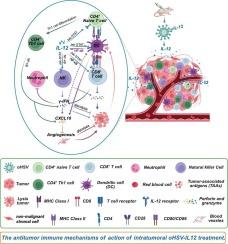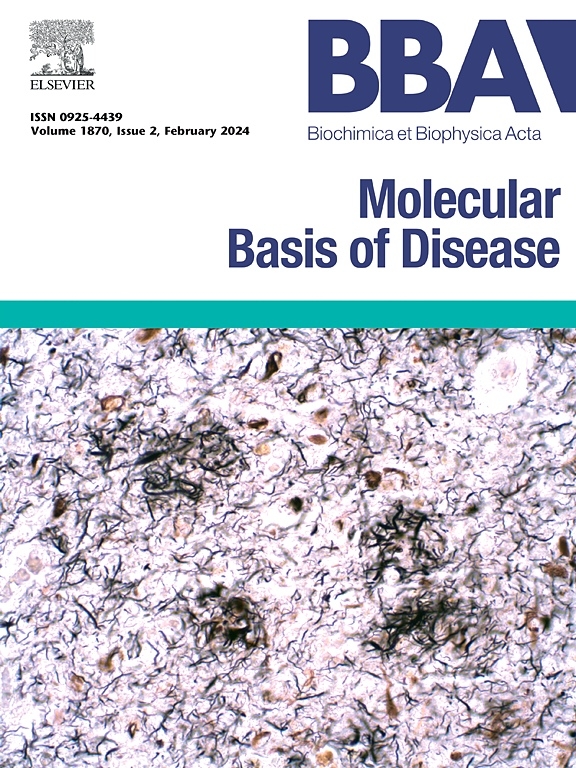表达白细胞介素12的工程溶瘤性单纯疱疹病毒抑制肝癌的致瘤性
IF 4.2
2区 生物学
Q2 BIOCHEMISTRY & MOLECULAR BIOLOGY
Biochimica et biophysica acta. Molecular basis of disease
Pub Date : 2025-09-11
DOI:10.1016/j.bbadis.2025.168033
引用次数: 0
摘要
溶瘤病毒(OVs)通过直接溶瘤活性和免疫调节转基因的表达介导抗癌作用。Talimogene laherparepvec (T-VEC)是一种基因修饰的溶瘤性单纯疱疹病毒1型(HSV-1),可分泌粒细胞-巨噬细胞集落刺激因子(GM-CSF),已获得美国食品和药物管理局(FDA)批准用于黑色素瘤治疗。然而,像T-VEC这样的早期OVs的临床疗效仍然有限,这凸显了增强其抗肿瘤效力和免疫激活能力的必要性。白细胞介素-12 (IL-12)是一种有效的免疫刺激细胞因子,可促进th1型反应,触发自然杀伤细胞(NK)、CD4+ T细胞和CD8+ T细胞产生干扰素-γ,从而表现出强大的抗肿瘤活性。在本研究中,我们构建了两种重组HSV-1 ohv - gmcsf和ohv - il12,并在H22小鼠肝细胞癌(HCC)模型中评估了它们单独或联合的抗肿瘤作用。引人注目的是,ohv - il12单药治疗实现了完全的肿瘤根除,超过了ohv - gmcsf的疗效。RNA测序分析显示,oHSV-IL12治疗增强了瘤内淋巴细胞的浸润和活化,同时上调了免疫相关基因和途径。值得注意的是,在再挑战和生存实验中,ohv - il12单药治疗与ohv - gmcsf和ohv - il12联合治疗的效果相当。这些发现表明ohsv - il - 12有望成为HCC免疫治疗的新候选药物。本文章由计算机程序翻译,如有差异,请以英文原文为准。

Engineered oncolytic herpes simplex virus expressing interleukin 12 suppresses tumorigenicity of hepatocellular carcinoma
Oncolytic viruses (OVs) mediate anticancer effects through direct oncolytic activity and the expression of immunomodulatory transgenes. Talimogene laherparepvec (T-VEC), a genetically modified oncolytic herpes simplex virus type 1 (HSV-1) engineered to secrete granulocyte-macrophage colony stimulating factor (GM-CSF), has received United States Food and Drug Administration (FDA) approval for melanoma treatment. However, the clinical efficacy of early generation OVs like T-VEC remains limited, highlighting the need to enhance their antitumor potency and immune activation capacity. Interleukin-12 (IL-12) is a potent immunostimulatory cytokine that promotes Th1-type responses, triggering interferon-γ production by natural killer (NK) cells, CD4+ T cells and CD8+ T cells, thereby exhibiting robust antitumor activity. In this study, we constructed two recombinant HSV-1, oHSV-GMCSF and oHSV-IL12, and evaluated their antitumor effects, alone or in combination, in H22 murine hepatocellular carcinoma (HCC) model. Strikingly, oHSV-IL12 monotherapy achieved complete tumor eradication, surpassing the efficacy of oHSV-GMCSF. RNA sequencing analysis revealed that oHSV-IL12 treatment enhanced intratumoral lymphocyte infiltration and activation while upregulating immune-related genes and pathways. Notably, the oHSV-IL12 monotherapy showed comparable therapeutic outcomes to the combination of oHSV-GMCSF and oHSV-IL12 in both rechallenge and survival experiments. These findings position oHSV-IL12 as a promising novel candidate for HCC immunotherapy.
求助全文
通过发布文献求助,成功后即可免费获取论文全文。
去求助
来源期刊
CiteScore
12.30
自引率
0.00%
发文量
218
审稿时长
32 days
期刊介绍:
BBA Molecular Basis of Disease addresses the biochemistry and molecular genetics of disease processes and models of human disease. This journal covers aspects of aging, cancer, metabolic-, neurological-, and immunological-based disease. Manuscripts focused on using animal models to elucidate biochemical and mechanistic insight in each of these conditions, are particularly encouraged. Manuscripts should emphasize the underlying mechanisms of disease pathways and provide novel contributions to the understanding and/or treatment of these disorders. Highly descriptive and method development submissions may be declined without full review. The submission of uninvited reviews to BBA - Molecular Basis of Disease is strongly discouraged, and any such uninvited review should be accompanied by a coverletter outlining the compelling reasons why the review should be considered.

 求助内容:
求助内容: 应助结果提醒方式:
应助结果提醒方式:


